Vijaya Roa is the first dance artist to introduce the form of Indian dance drama called “Nritya Nataka” in Europe, which has contributed significantly to the understanding of Indian dance and its acting. Vijaya Rao has produced numerous choreographic works based on Indian mythology and classical literature as well as Western themes, both solo and ensemble. Her love for the Sanskrit language and the ancient Indian literature, her in-depth knowledge of Raga(melody), Thala(rhythm) and Nattvangam(cymbals) have helped create masterpieces that range from heroes/Gods – Gautama Budha, Jesus, Sharavana Bhava, Ganesha, Rama, Dasha Avatar, Dasara Pada to classical heroines – Maria Magdalene, Mother Mary, Savitri, Princess Mohanvalli, Shakuntala, Sita, Shakthi and Ashta Nayaki, in addition to exploring the Spiritual elements in Bharata Natyam. From folk(Alagar Kuravanji) to Raga Malika, Thala Malika in ‘Shrishti’ to serious Abhinaya in ‘Ashta Nayaki’, the range of music and dance covered is both extensive and exhaustive.
Gautama Buddha

Dance program with Vijaya Rao and Nateschwara Dancers
Content: 'Gautama Buddha' tells the life story of Buddha in the form of a musical Indian dance act in dance, gestures and facial expressions in an expressive, poignant way. The play takes the viewer on a journey into the time of the Buddha and tells in different episodes his life, his birth, his worldly and ascetic experiences, to his enlightening realization.
Program: 'Gautama Buddha' is a colorful masterpiece, rich in melody and rhythm. It is a symbol of peace that moves the audiencebecause it expresses the fulfillment of the yearning of all people. The 7-member dance ensemble consists of Vijaya Rao and the Nateschwara Dancers and a three-member Indian music ensemble (vocals, percussion and string instrument Vina).
Ramayana – The story of Rama

Dance program with Vijaya Rao and Nateschwara Dancers
Content:The epic Ramayana tells the story of the God-hero Rama, who is banished together with his wife Sita for 14 years in the jungle. There Sita is kidnapped and Rama sets off on the long journey to free his wife. At the heart of the program is the song “Bhavayami Raghuramam”, which portrays in single stanzas one or more episodes from the life of the noble God-hero Rama and his wife Sita.
Program:The Ramayana is the oldest and best known of the two great epics of India. It is handed down to us in several versions, and includes in the most famous form, that of the sage Valmiki, about eighteen thousand verses. “Bhavayami Raghuramam” is a musical composition based on the poem of Swathi Thirunal and was set to music by Semmangudi Srinivasa Iyer in seven ragas according to the mood of the various scenes and actions of the epic.
Link to photo GalleryOm Namah Shivaya – Ode to the Dance God!

Dance program with Vijaya Rao and Nateschwara Dancers
Content:The program features episodes from the mythological tales of Lord Shiva and his wife Parvati. At the same time, Lord Shiva is the king of dance, and with his cosmic dance he has brought about the destruction of the old world and the conditions for the creation of the new world. His wife Parvati is the daughter of the king of the Himalayas and has only been able to win her husband’s heart through years of asceticism.
Program:In this traditional Bharata Natyam dance program, impressive choreographies are lined up. The musical and dance performance can be enjoyed like a musical. The program was choreographed and built by Shri Pathagudy Ramaswamy.
Abhijnana Shakuntalam – Recognition of the Shakuntala

Dance program with Vijaya Rao and Sharmila Rao
Content: Shakuntala is the daughter of the heavenly nymph Menaka and the ascetic sage Vishwamitra, but is raised in the forest by the hermit Kanva. One day she meets the attractive King Dushyanta, the couple fall in love and get married. However, fateful events lead the king to not recognizing his beloved wife anymore. When the curse that led to this oblivion is lifted, the unfortunate king remembers his beloved and sets out in search of Shakuntala.
Program: Mahakavi Kalidasa, one of the most important poets of India, penned the enchanting love drama “Recognition of the Shakuntala” in the 2nd century AD, it is written as a play in seven acts for the stage. The piece is about the time of the Vedic high bloom of India over 5000 years ago. Kalidasa's drama was the first Indian poetry to be translated into English and German, and has inspired greats such as Goethe and Schoppenhauer. Vijaya Rao has choreographed the piece as a Bharata Natyam-style dance drama for two dancers using original Sanskrit verses of the piece. These were set to music by the music teacher Shri N. Purushothaman. Vijaya Rao has reduced the approximately 32 performers to the essential 17. She and Sharmila Rao take turns playing several of these characters.
Link to photo GalleryJesus Charitam – Jesus of Nazareth
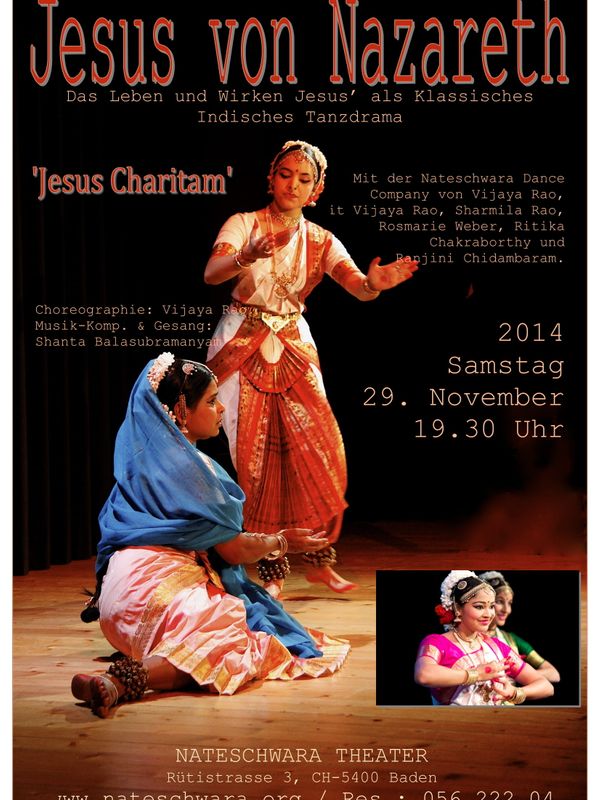
Dance program with Vijaya Rao and Nateschwara Dancers
Content: “Jesus of Nazareth” is a Bharata Natyam-style dance drama that goes beyond the usual clichés and presents a refreshingly new and unusual dimension of the biblical-historical interpretation. In moving scenes with expressive drama and dynamic dance, framed by atmospheric music, selected episodes from the New Testament are told and brought to life in an impressive way. Scenes that touch profoundly, such as when Jesus's mother Mary sings the beauty of her child and virtuoso dance performances for example-the beautiful Salome, who is not stingy with her charms before Herod, immerse the audience in a pleasant, changing pool of emotions. The piece delights with its undogmatic, colorful presentation – a wonderful experience that is a special pleasure both in dance and in music.
Program: Vijaya Rao has choreographed a dance drama with “Jesus of Nazareth”, which is unique of it's kind. A total of 24 ragas breathe this piece of emotion. The texts written by Anton Tönz were translated to Sanskrit verses by Dr. Ing. Jaydev Jani of the University Baroda (India). These were then set to the classical South Indian music by the Indian singer Shanta Balasubramanyam from Bombay and Vijaya Rao.
Link to photo GalleryAlaghar Kuravanji – the beautiful fortune teller

Dance program with Vijaya Rao and Nateschwara Dancers
Content:The story is about the love of beautiful Princess Mohanavalli for God Vishnu. The immortally in love princess suffers from love pain and with the help of her friends undertakes various attempts to win Vishnu’s attention. In the course of the fateful story, the fortune teller Kurati appears, promising the princess a happy end to her quest.
Program: “Alaghar Kuravanji” is a traditional dance show from South India. The piece was written in the 18th century by the Indian poet Kavi Kunjara Bharati and set to music and choreographed by Bharata Natyam master Pathagudi S. Ramaswamy. “Alaghar Kuravanji” impresses with its folk-influenced style of presentation, the mischief in the drama and the lush dance routines, which give the piece a varied dynamic.
Link to photo GalleryAshta Nayaki – The eight states of mind of a woman

Dance program with Vijaya Rao
Content:The classical Indian dance is mainly about love and devotion to God. The dancer is the devotee(god worshiper) and her lover is God. She expresses in dance all the emotions and moods of a woman in love for her lover. The classical Indian scriptures distinguish eight characteristic emotions that a woman experiences in her love for a man. Many Indian musicians and poets have expressed their love and devotion to God through one of these eight states of mind in their works.
Program: The concept of Ashta Nayakis has been used in musical compositions since the 12th century. Most of the dances in this program are by the famous poet and musician Kshetrajña (17th century). Vijaya Rao gives an insight into the diverse emotional world of the woman by means of individual dances. Delicately nuanced expressive dances depict the emotional states of various female characters – a rare, exceptionally emotional performance.
Link to photo GalleryJaya Ganesha – Ode to Ganesha

Dance program with Vijaya Rao and Nateschwara Dancers
Content:“Jaya Ganesha” is thematically dedicated to the mythical figure Ganesha, the eliminator of all obstacles. Dynamic and atmospheric dances take turns to tell of Ganesha’s auspicious qualities and mythological episodes about him.
Program: The program impresses with impressive choreographies and intoxicating music. The dance program was produced and choreographed by Vijaya Rao specifically for the 30th Anniversary of Nateschwara Academy.
Link to photo GalleryKelano Hari
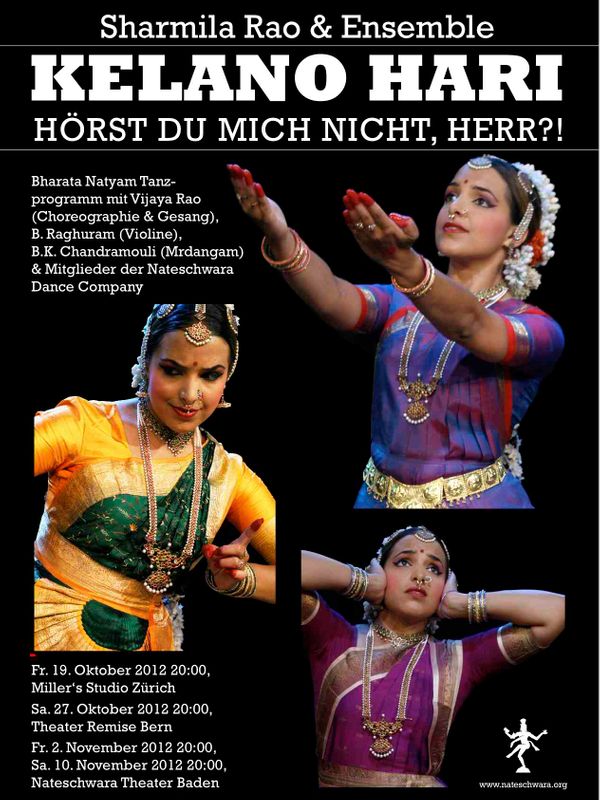
Dance program with Sharmila Rao
Content:The program “Kelano Hari” is a compilation of songs by the Indian poet and singer Purandaradāsa, choreographed in classical Indian dance style Bharata Natyam. His songs not only speak of the gift of God and the yearning for salvation, but also of the weaknesses and inadequacies of people who devote their lives to hypocrisy rather than true love of God. At the heart of the program is the composition “Arige Vadhuvade” in which Purandara jokingly asks Goddess Lakshmi, in which of the many manifestations of Vishnu is now her husband.
Program: “Kelano Hari” is based on the dissertation of Sharmila Rao. The program “Kelano Hari” has grown thanks to the co-operation of experts to a high-level dance program. Sharmila Rao edited the texts of the compositions with the support of Prof. Viveka Rai, the selected compositions were choreographed and artistically realized by Vijaya Rao especially for this production.
Link to photo GallerySavitri – An Indian love story

Dance program with Vijaya Rao and Sharmila Rao
Content:“Savitri” is the symbol of a strong woman who hides behind pictorial beauty and a great repartee. The dance theater shows an episode from the great Indian epic Mahabharata. It tells the story of Savitri, whose husband dies shortly after her wedding. The god of death Yama comes to get his soul. But Savitri does not release her husband so easily and follows Yama into the otherworldly world. The stubbornness and ingenuity of Savitri eventually forces Yama to return her husband’s soul. The play “Savitri” provides the answer to the question of whether the fate of death is surmountable and proves that fate can be overcome with the power of love and the pursuit of justice.
Program: “Savitri” is conceived as a dance theater in seven acts.
Link to photo GallerySpirituality in Indian Dance

Dance program with Vijaya Rao
Content: As the dancer grapples with the contents of the dance and internalizes them, a spiritual extension is created that provides a deeper insight into human and cosmic contexts. In this way, the Indian dance in addition to its unique artistic touch also has a significant spiritual component. This program with selected dance pieces and brief explanations of the dances opens the viewer to this spiritual dimension of classical Indian dance. The interpretation of the themes covered in the plays reveal the fundamental sacral character underlying Indian art.
Program: This program was compiled by Vijaya Rao after years of intense engagement with the deeper meaning of the dance themes in Bharata Natyam. Vijaya Rao knows how to bring the sacral themes of Indian dance into appropriate contexts with great empathy and to demonstrate their universality.
Link to photo GalleryOm Sharavana Bhava – Praise to God Kartikeya
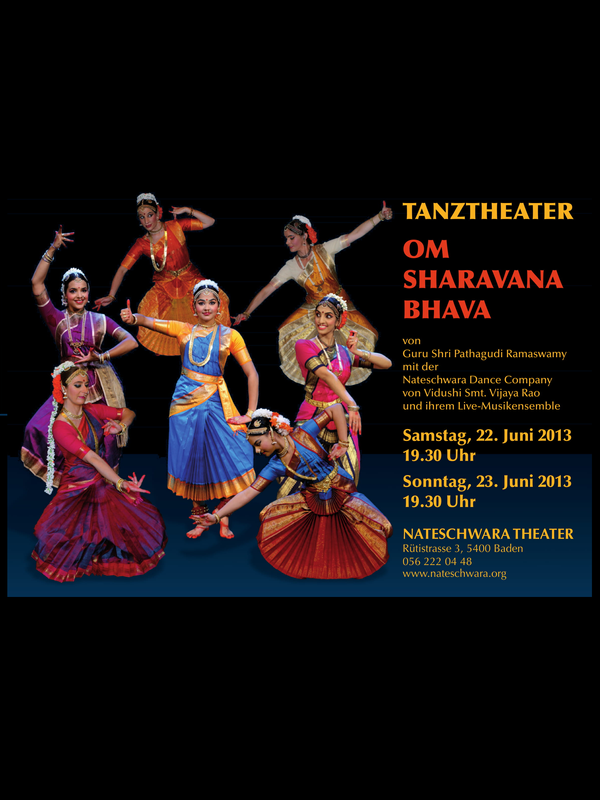
Dance program with the Nateschwara Dancers
Content:This program is a chorus of praise to God Kartikeya, son of God Shiva. A presentation of not less than 16 dances praises this divinity, who is mainly worshiped in South India.
Program: The dance master ShriPathagudi S. Ramaswamy who passed away in 1997 penned “Om SharavanaBhava”. It is arranged out of compiled compositions as well as self-composed pieces and constitutes the work of a lifetime of this great singer, choreographer and composer.
Link to photo GalleryDivya Darshanam – image of the Divine
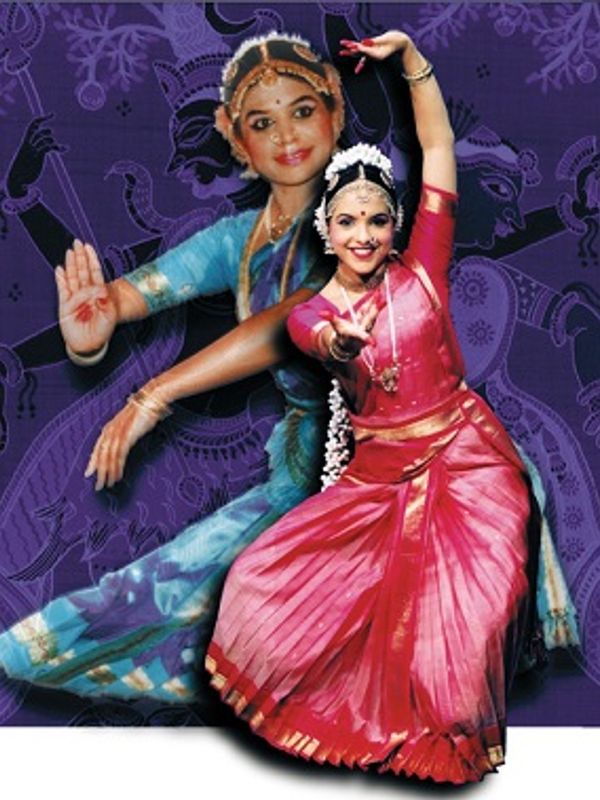
Dance program with Vijaya Rao and Sharmila Rao
Content: “Image of the Divine” is a dance program in which the mythical origin of Indian dance is told - from the cosmic dance of the god Shiva, the feminine celestial dancers and the sacred temple dances to today’s stage performance. Historical testimonies in the form of epic narratives from ancient dance textbooks and textbooks, such as the two-thousand-year-old Sanskrit work Natya Shastra are combined here into a complete work. Vijaya Rao has supplemented these with her own compositions. In this way, a dance spectacle has emerged, which bears witness to the immortality of this art. As representatives of this tradition, Vijaya Rao and Sharmila Rao emphasize the relevance of their heritage and build a bridge between past and present.
Program: The production “Image of the Divine” is based on the book of the same name by Vijaya Rao. In this program, she and her daughter Sharmila Rao offer the audience virtuoso dances, mythical narratives and poetic interludes surrounded by specially composed music, which once carries away moody and at other times rhythmically accentuated.
Link to photo GalleryIndia up close – Indian art as an intercultural encounter
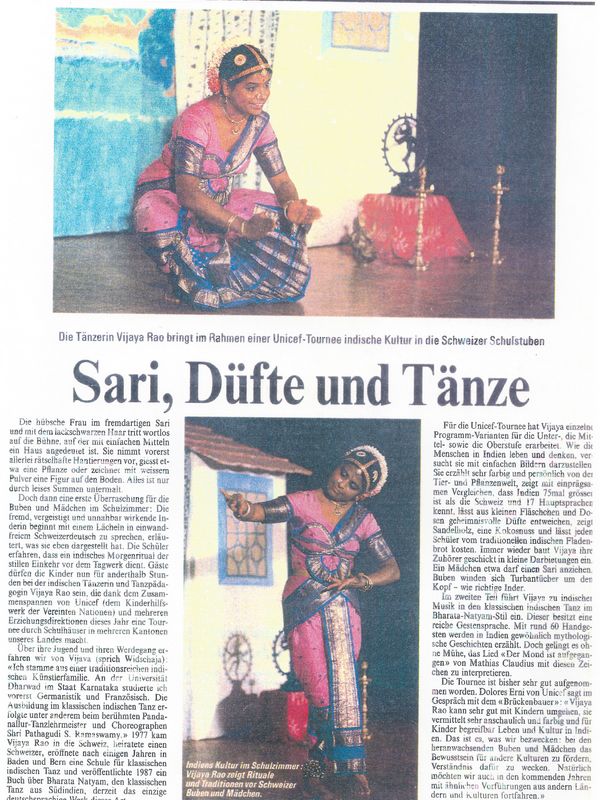
Cultural program with Vijaya Rao
Content: As a former UNICEF cultural ambassador, Vijaya Rao looks back on many years of experience in cultural exchange and intercultural exchange. Since the beginning of this commitment, various programs have been developed around this topic, which are presented in an interactive form. The program consists of different variants adapted to the age of the participants or the occasion.
Program: In a varied, playful program, which is particularly suitable for children and adolescents, art, life and customs in India are presented in a lively cultural encounter. For senior students or teacher training, the program also consists of an interactive lecture focusing on Hinduism. With the main focus on dance and music, the program leads by means of demonstrations, on request with participation of the participants, through the Indian arts and explains their present importance for the culture and society of India.
Link to photo GallerySrishti – The Creation
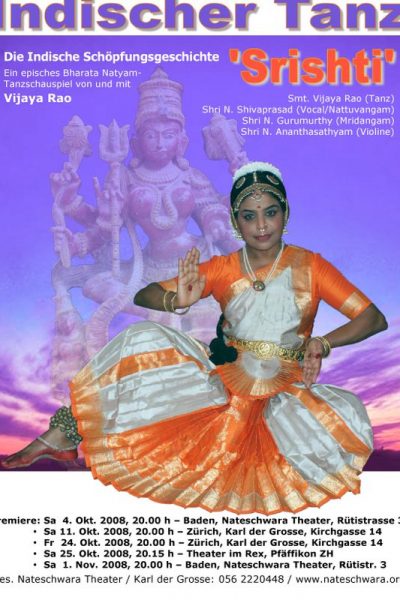
Dance program with Vijaya Rao
Content: 'Srishti' is a unique classical Indian dance show in Raga and Tala Malika, i. a garland of ragas (tone modes) and talas (rhythm cycles). It tells from the Indian mythology, how the Lord of the world, Vishnu is born from the primeval water and awakens the divine power Shakti, the feminine aspect – who brings forth the creation, and how Vishnu is embodied in each creation epoch as the Redeemer of human beings in the form of divine incarnations (Dasha Avatar) on this earth again.
Program: Vijaya Rao has used original Sanskrit texts from the Rigveda, the Devi Bhagavatam and other source texts, with compositions by Shri Maharaja Swathi Thirunal and the legendary musician Shri Shyama Shastri.
Link to photo Gallery